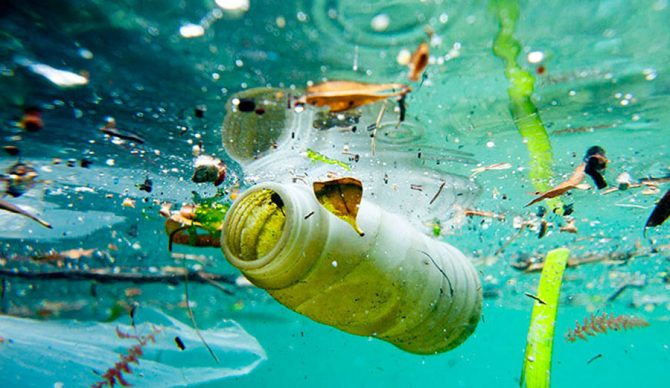We publish below an article on plastics initially written on January 2020. The discussion in society, in the movements and in the left on the issues of environmental destruction and the climate crisis is still continuing, as we head towars the COP26 summit in Glasgow this November. We believe that the positions presented in this article can contribute in these discussions.
Eleni Mitsou
What do children’s toys, contact lenses, acrylic, polyester and nylon fabrics, car seats and dashboards, trainers, house paints, nail polish and mascara have in common? They are made of plastic or contain plastic in large quantities. Plastic became an industrial product in the late 1950s. Since then our lives have been “built” on plastic. [1]
Seventy years later, plastic has not only conquered every aspect of our lives, but it has also invaded every corner on earth. Plastic waste has been found in the Marianna Trench, the deepest point in the ocean (11km from the surface)[2], in the Arabic desert [3], in the waters, ice and snow in the Antarctic [4], in the snow in the Alps and the Arctic cycle [5], and in the stomach and guts of innumerable animals. Whales [6], cows [7], deer [8] and camels [9], are some of the animals found dead with their stomachs filled with plastic.
The pollution from microplastics (small plastic particles, less than 5mm long, which have either been produced with that size or are fragments from bigger plastic products) and nanoplastics (plastic fragments smaller than 100nm) is of even greater scale. Microplastics and nanoplastics have been detected in the water we drink [10], in salt, honey and beer [11], in the guts, stomach and flesh of fish [12] and chicken [13], in the rain [14], even in the air we breathe [15]. Plastic is everywhere, including in our bodies [16].
The consequences from the “reign” of plastic in our lives are very serious. They involve our health and the survival of countless species on the planet. In addition, recent studies have proven that plastic contributes to global warming and the climate crisis.
The ban on single use plastics (although absolutely necessary) and the increase in recycling rates cannot solve the problem. We have to deal with plastics in the same way we have to deal with fossil fuels: We have to demand and struggle to replace them with safe and ecological materials in all uses – with possible small-scale exceptions that have to be discussed concretely.
The main four reasons that we have to struggle for the abolishment and replacement of plastics are briefly explained below. It is needless perhaps to stress that it is not possible to fully exhaust such a complex topic in the length of an article.
1. Plastics pose serious hazards for our health
Plastics are artificial materials (solid or liquid) produced by the chemical industry. The industry has no obligation to prove that a type of plastic is safe for humans and the environment before it is used in production. At the same time, state authorities and international organisations have not developed an efficient control system to check all the substances produced.
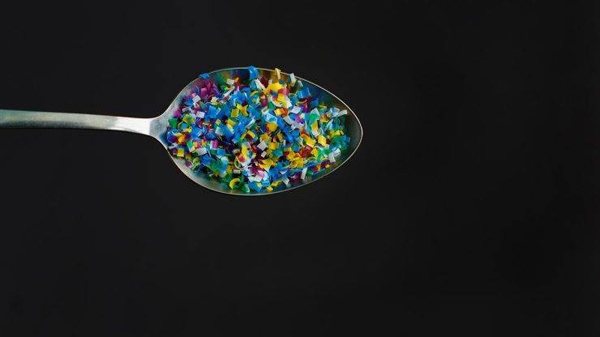
Dangerous “building blocks” and additives
Serious health hazards are posed both by the “building blocks” of plastic and by the “additives” used [17], which are indispensable in order to give plastic its different properties, such as flexibility, resistance to heat, flame retardancy/reduced flammability, lubrication, resistance to UV degradation, etc.
The example of Styrene
Styrene (S), for example, is a building block of Polystyrene (PS), a type of plastic widely used to manufacture single-use plastic cups and food packaging. It is also a substance found in many other plastic objects (e.g. razors, school rulers, water pipes, insulation materials, tyres, fiberglass products, etc.) and in the ink used in printers and photocopy machines.
The neurotoxicity of styrene has been known for decades. At the same time, a number of researches have shown that it is also a carcinogen – the styrene industry, of course, refutes this. Yet we eat, drink and breathe styrene. It leaches from the polystyrene packages and migrates to our food and beverages and “floats in the air” when we use printers and photocopy machines, among other examples.
The example of flame retardants
When it comes to plastic additives, flame retardants are one of the most characteristic examples. They are found in many different plastic products, from children’s toys to TVs and computers, mattresses, curtains, car seats, and furniture foam and upholstery.
Although there are many different types of flame retardants they have all been linked to health hazards in one or more of the following main systems of the human body: the immune, nervous system, reproductive and endocrine systems. Among other things, they can cause cancer (especially in the liver and the womb), thyroid disruptions, learning disabilities, delayed mental and physical development, obesity and fertility problems.
A number of flame retardants like the “Polybrominated Diphenyl Ethers” (PBDEs) and the “Short-Chain Chlorinated Paraffins” (SCCPs) have been characterised as Persistent Organic Pollutants (POPs). These are pollutants persistent in the environment because they are resistant to the natural chemical, biological, and photolytic degradation processes. In addition, they accumulate in the bodies of humans and animals with serious adverse impacts on health and the environment. [19]
Yet, flame retardants literally run in our blood. Many studies have detected “Polybrominated Diphenyl Ethers” (PBDEs) in the blood samples of more than 90% of people tested in the US and “Short-Chain Chlorinated Paraffins” (SCCPs) have been repeatedly detected in the breast milk of women tested in China. In general, in our lifetimes the highest exposure to PBDEs, SCCPs and other flame retardants is considered to occur during breastfeeding. [20]
Plastics attract Persistent Organic Pollutants
Apart from the dangerous “building blocks” and additives, plastic has yet another dangerous property. When it is in water, it attracts and “absorbs” Persistent Organic Pollutants (POPs). POPs are extremely persistent pollutants, mostly products or by-products of industrial activity (or other human activity), and are very toxic for living organisms.
Among the most known Persistent Organic Pollutants are dioxins (for ex. 2,3,7,8-TCDD) and furans, Polychlorinated Biphenyls (PCBs), polycyclic aromatic hydrocarbons (PAHs), etc.
According to the World Health Organisation (WHO), exposure to Persistent Organic Pollutants, even at low levels, “can lead, among others, to increased cancer risk, reproductive disorders, alteration of the immune system, neurobehavioural impairment, endocrine disruption, genotoxicity and increased birth defects” etc. [21]
One of the ways plastics that have “absorbed” POPs end up in our bodies is through the fish and shellfish we eat, that have in their guts, fat and meat microplastics.
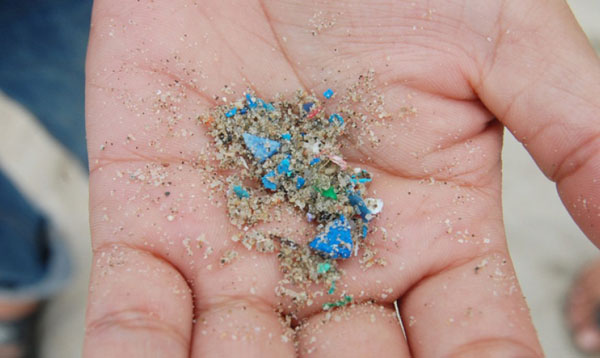
“Consuming” microplastics and nanoplastics
Microplastics and nanoplastics are everywhere. In the air we breathe, in the water we drink, in our food, in rainwater, etc. In the advanced capitalist countries, it is estimated that the average person consumes up to 5gr of plastic every week, which is the equivalent of a credit card! [22]
Although there are not yet enough studies on the effects of microplastics and nanoplastics “consumption” on our health, scientists are alarmed. Research presented in the first Plastic Health Summit showed that immune cells attack microplastics and in many cases end up dying at a faster pace, that the growth of the airways is hindered by nylon fibers and that microplastics probably penetrate the placenta. [23] These are added to the knowledge scientists already have that plastics have toxic effects and that they attract persistent organic pollutants.
Are there safe types of plastic?
In a research published in 2011 in the “Environmental Health Perspectives” scientific magazine, scientists tested more than 450 commonly used plastic products, made of different types of plastic and purchased in different stores.
The researchers focused on the question whether these products leach chemical substances that affect the endocrine system, like for example BPA and phthalates do, which mimic oestrogen and other hormones produced by the human body.
“Almost all commercially available plastic products we sampled — independent of the type of resin, product, or retail source — leached chemicals having reliably detectable EA [estrogenic activity], including those advertised as BPA free. In some cases, BPA-free products released chemicals having more EA than did BPA-containing products.” [24]
A few examples of the health hazards of chemicals that affect the endocrine system (endocrine disruptors) are the following: They are linked to autism, children’s asthma and a number of cardiovascular health problems such as hypertension, arrhythmia and heart attacks. They also elevate the chances for breast and prostate cancer, they can suppress insulin production leading to diabetes II, they can provoke alterations to the DNA and they can lead to obesity, erectile dysfunction, decreased sexual desire and decreased ability to handle stress [25].
Almost all diseases that have dramatically increased in the past 50 years, from obesity to autism and from cancer to the auto-immune diseases of the nervous system, are linked, among other things, to plastic.
In the documentary “Plastic Planet,” [26] the film director Werner Boote, speaks about this issue with Frederick vom Saal, a distinguished Professor of Biological Sciences in the University of Missouri
Fred vom Saal : I would say that at this time we cannot state that there is any safe plastic.
Werner Boote : We’re still alive.
Fred vom Saal : That’s a very good point. These chemicals do not kill you. They just harm your quality of life. They give you asthma. They lead to obesity. They lead to brain disorders.
Werner Boote : On the other hand, all those materials help me to stay alive as well. When I’m going to the hospital, everything is made out of plastic.
Fred vom Saal : Yes. On your way to the hospital for chemotherapy and radiation therapy for the cancer caused by these chemicals, you ask yourself, “Have they really improved the quality of the life I am living?” That’s the question.
2. Plastic kills wildlife silently
BBC Documentary “Blue Planet II” shows, among other things, the scale of plastic pollution in the oceans. In one of the episodes it films albatross feeding their chicks plastic debris instead of fish and molluscs. Plastic in the sea is colonised by algae and other microorganisms. After only a few days they smell and look like food and they are consumed by millions of seabirds, leading them to a slow death. [27]
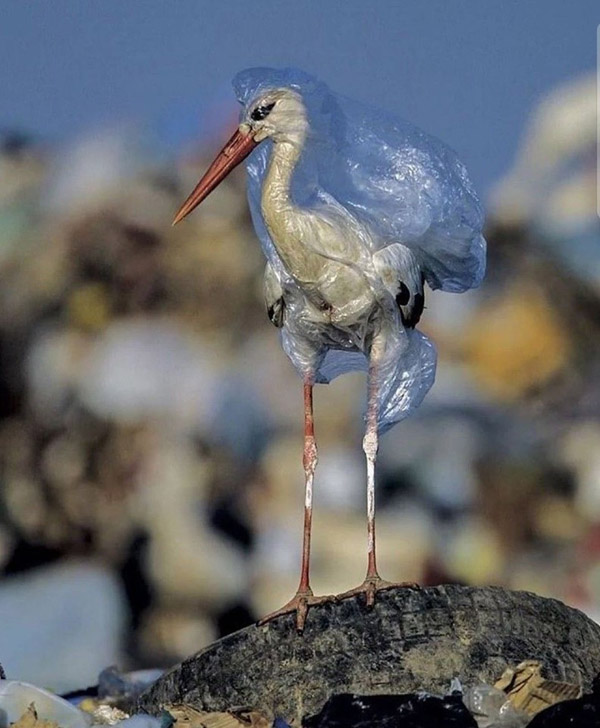
It is estimated that on an annual basis plastic debris kill approximately 1 million seabirds [28], 100.000 marine mammals (dolphins, whales, seals, etc) [29], countless fish and other marine species.
The problem is not limited to the sea. Cows, deer, bears and many other animals are being killed because they have been eating plastic waste. In the United Arab Emirates, one out of two dead camels has been found to have died because of the plastic it has consumed [30].
Plastic kills wild and domestic animals in many ways. There are many photographs on the internet showing how commonly used plastic objects end up functioning as death traps for animals (e.g. birds tangled in plastic bags, sea turtles with plastic straw in their nostrils, etc).
In addition, there is evidence that the pollution of the oceans and rivers with plastics can cause infections, hormone disruption, reduced fertility and even hermaphroditism to the fish and other animals! [31]
The above are only some of the effects of plastic pollution in the ecosystem. The scientific community clearly states that the full effect is still not known. [32]
3. Recycling is not the answer to plastic pollution
99% of plastic today is made from hydrocarbons (natural gas and oil, whereas, in China coal is also used to produce plastic) and does not biodegrade. It breaks up into smaller and smaller pieces, reaching, the nanoscale but it does not break down to its constituent elements (carbon, hydrogen, etc). Every plastic ever made, continues to exist on earth in some form, with the aforementioned dramatic consequences for humans, animals and the environment. [33]
Since the 1950s, 8,3 billion tons of plastic have been produced [34]. Every year another 300 million tons of plastic are being added on the earth, with half of it being single use plastics [35].
At the same time, only 9% of the plastic produced globally is being recycled. The rest ends up one way or another in the water, the earth, the air and in the bodies of animals and humans.
But, can the problem of plastic pollution be solved if we heavily invest in recycling facilities and dramatically raise the amount of plastic we recycle? The answer is no! Much of the plastic produced is not recyclable – it is manufactured in a way that it cannot be recycled. But also the plastic that can be recycled is usually only recycled once and could theoretically be recycled only a few more times (usually two to three times).
Unlike glass and metals (including aluminium) plastic does not have an open recycling cycle [36]. So, recyclable plastic after 1, or maybe 2 or 3 cycles of recycling, will end up in a landfill or will just be thrown away directly in the environment (as it happens in countries that don’t have a waste management system or have an inefficient one).
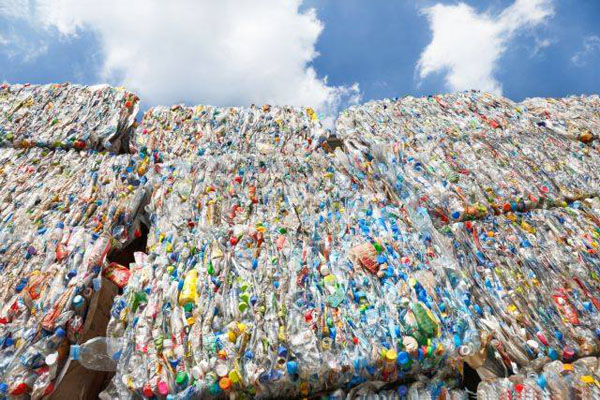
Of course, neither is incinerating plastic a safe form of managing plastic waste – although waste incineration is widely practiced in many countries. Waste incineration, even in the most modern incineration plants, produces toxic air pollutants like dioxins, furans, benzene, chlorofluorohydrocarbons (CFCs) and other persistent organic pollutants. Equally toxic and full of dangerous and toxic heavy metals is the bottom ash produced, whose long-term safe management is practically impossible.
4. Plastic contributes to global warming and the climate crisis
It is estimated that plastic produced in 2019, during its lifecycle (extraction, refining, manufacture, incineration) has added more than 850 million metric tons of greenhouse gases to the atmosphere. This is equal to the annual emissions of 189 five-hundred-megawatt coal power plants. With plastic production expected to grow rapidly in the next years, it is estimated that by 2030 the annual emissions of plastic will equal the emissions annually produced by 295 five-hundred-megawatt coal power plants and by 2050 the emissions of 615 five-hundred-megawatt coal power plants. It is important to note that the scientists that conducted this research state that their calculations are conservative, due to lack of access to important data [37].
In addition, the emissions mentioned above don’t include the greenhouse gas emissions from the open burning of plastic, from incineration that occurs without any energy recovery from plastic waste in landfills or from plastic thrown away directly in the environment. These last two cases are actually of great importance.
When degrading plastic materials are exposed to solar radiation they emit methane and ethylene. Emissions continue even after the sun is gone and at night. The rate of emissions increases with time, as plastic further degrades [38].
Methane and ethylene are two powerful greenhouse gases. Methane is 30-35 times more potent than CO2 in global warming. Taking into account that there are billions of tons of plastic waste out there but also degrading plastic objects still in use, it is evident that they contribute significantly in global warming and the climate crisis.
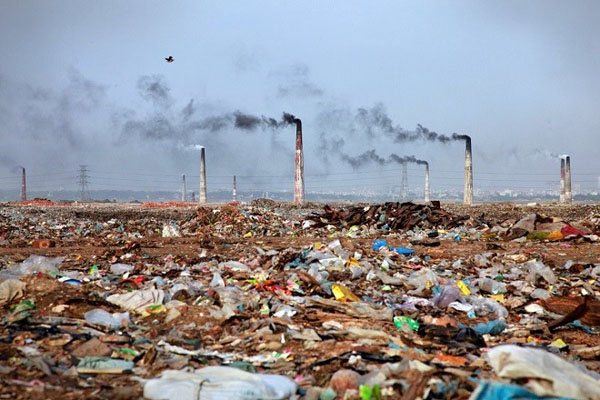
Plastic contributes to the climate crisis in yet another very important way. It affects the ability of the oceans (the biggest carbon sink on earth) to “absorb” CO2. It affects the growth of phytoplankton and its ability to use CO2 and photosynthesize. At the same time, plastic affects zooplankton, which deposits CO2 in the ocean seabed – zooplankton eat phytoplankton that have binded CO2 and deposit it, in the form of faeces, on the ocean seabed. In addition, researchers have found that zooplankton prefer to eat microplastics than phytoplankton. Also, that zooplankton that have eaten microplastics eat 40% less phytoplankton. [39]
Are there alternatives to plastic?
How should we deal with a material that affects the health of humans and animals, that does not biodegrade, does not have an open recycling cycle and contributes in many ways to the climate crisis? We have to fight for the immediate ban of single-use plastics, the gradual replacement of plastic in all of its uses (in the near future) and direct significant resources and funds to the research for safe and ecological alternatives to plastic.
Some steps have already been made in that direction. For example, there are companies producing packaging materials made of mushrooms, there are scientists that have produced fabric from sour milk and banana peels, etc [40]. In addition, new ways have been found to process “traditional” materials like wood. Liquid wood technology for example allows wood to take shapes and properties which in the past would demand intense labour, skill and high costs. [41]
All of the above-mentioned alternatives and many others must be further researched in order to assure that they are safe in respect to our health and that their use on a large/mass scale will not have adverse effects on the environment, society and life. For example, some of the “eco-plastics” or “bio-plastics” (PLΑs – Polylactic Acid etc) made of corn starch, sugar cane, etc. have been found to have estrogenic activity, similar to the one of conventional plastics [42].
It is not so many years ago that the use of corn and other plants for the production of biofuels shot up their price in the global market, leading, among other things, to revolts in a number of developing countries whose population could not afford basic food commodities anymore.
We also have the experience of agrobusiness and the natural product industry that provoke huge ecological disasters. In Indonesia, for example, and in other countries rainforests are being cut down and replaced with palm trees because palm oil is the most traded vegetable oil in the world.
We can look for alternatives in order to replace multipurpose and single-use plastic objects that at this phase of technological development and knowledge cannot be abolished (for example in medicine). However, no plant or natural material exists on this planet that can sustain, without severe environmental consequences, a “culture” that discards 500 billion single use plastic cups annually. [43]
We also need to acknowledge that none of the above-mentioned materials or any renewable resource, for that matter, can sustain the “overconsumption model” of the “advanced” capitalist world. A model that doesn’t have to do with the personal choices of people, millions of whom live in poverty, but with the way capitalism and the markets are organised and the ideas they cultivate and promote.
Therefore, replacing plastic must be combined with the “rejection” of single-use items (with certain exceptions, as mentioned above) and the “throw-away culture.” Capitalism deliberately fosters single use with build-in obsolescence, incessant advertising, constantly changing fashion and minor upgrades. It must be also combined with a rejection of the current consumption model, in general, in the developed world, cultivated by the capitalist industry, particularly the food and fashion industries. A model where for example there are not enough hospital beds available, nor enough social housing, where capitalist claim a better public education system cannot be afforded, nor higher pensions, salaries etc, yet, at the same time around 30% of the food produced globally is thrown away before it reaches consumers (among other reasons because it doesn’t fit the aesthetic standards the food industry has cultivated), 30% of the clothes produced are never sold and many industries (from H&M to Burberry) end up in burning them [44]. Even pro-capitalist commentators have started to criticise some aspects of the consumption model that has been cultivated by capitalism such as the overconsumption of meet and sugar, among other reasons because this leads to higher social security costs. Rejecting the current consumption model does not mean that we aim at lowering living standards or live a spartan life – on the contrary we aim to raise living standards for all workers and poor. It means, we have to redirect industrial and agricultural production and cultivate a different value system in society, motivated not by profit but by what is better for society, the health of its members, nature and the environment.
In this direction we can find solutions that can replace plastic in its different uses. These include replacing plastic with natural materials, such as metals and wood in some fields, with biodegradable polymer materials (e.g. made of mushrooms or food waste) in others, with solutions which will likely come from the new field of biomimetics (synthesis of materials that have functions that mimic biological processes) etc.
There can be no solution in the framework of capitalism
Can we redirect and make the drastic changes needed to the economy and industrial production, in the framework of capitalism? Can we convince the plastics industry to invest in new technologies and stop producing plastic? Can we convince the hydrocarbon industry to abandon hydrocarbons and turn to renewable energy sources, hydrogen [45] and other green technologies? Can we convince the 26 people [46] that have as much wealth as half the population of earth to share it? The answer is, of course, no. In the same way that we cannot end hunger, poverty, exploitation and misery without overthrowing capitalism, we cannot save life and human civilisation as we know it on this planet without fighting to end the dictatorship of the markets and of the billionaires and to build a socialist society that respects the environment and life’s link to nature.
We thus need to fight for:
- An immediate ban on single-use plastics (with small scale exceptions in fields such as medicine) and drastic reduction of plastic packaging. Plan the replacement of plastics by natural materials and the other (truly) green solutions in the near future.
- An immediate plan to end the use of hydrocarbons for energy and plastics production.
- Big increases in public funding for democratic and independent scientific research to further develop safe and environmental friendly materials that will replace plastic, to better understand and combat climate change, to further develop renewable energy, hydrogen and other green technologies for the production and storage of green energy, etc. Government money that is now spent on subsidies, tax breaks and incentives for fossil-fuel corporations and the plastics industry should be directed to research. The results of this research should belong to the whole of society and be used for common welfare. They should not be allowed to be bought, patented and used for profit by big business.
- Nationalisation under workers control and management of the hydrocarbon industry. Turn the industry in the direction of renewable energy sources, hydrogen, and other green technologies, at the same time guaranteeing there are no job losses and no cuts on workers’ wages and rights.
- Plan economy and production according to the real needs of society and not for the profitability of a small minority – the millionaires and billionaires of this world.
- Nationalise all key industries under workers and social control, including the plastics industry. Replace plastics with ecological and safe materials retraining all the workers and guaranteeing all jobs with no cuts to workers’ wages and rights.
- Expansion of jobs both for environmental repair and protection, and for society. Invest in renewable energy, hydrogen and other green technologies, repairing environmental damage, building eco-friendly homes, public transit, retrofitting buildings for energy efficiency, greening cities, etc. All jobs to be union organized with good training, pay and conditions.
- International coordination of the struggle. Plastic pollution, climate change and many other environmental problems cannot be solved on a national basis. Solutions and planning can only be viable if implemented on an international level.
- The overthrow of capitalism and the building of a society without oppression, poverty and misery, a socialist society where all decisions will be made through truly democratic procedures and be driven by the well-being of the vast majority of society, workers and youth.


